 Website:
FCI Fluid Components International
Website:
FCI Fluid Components International
Flow Meter Selection for Improved Gas Flow Measurements: Comparison of Differential Pressure and Thermal Dispersion Technologies
1 /
6Pages
Catalog excerpts
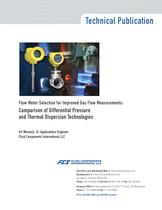
Technical Publication Flow Meter Selection for Improved Gas Flow Measurements: Comparison of Differential Pressure and Thermal Dispersion Technologies Art Womack, Sr. Applications Engineer Fluid Components International LLC Visit FCI on the Worldwide Web g www.fluidcomponents.com Headquarters g 1755 La Costa Meadows Drive San Marcos, California 92078 USA Phone 760-744-6950 g Toll Free 800-854-1993 g Fax 760-736-6250 European Office g Persephonestraat 3-01 5047 TT Tilburg, The Netherlands Phone 31-13-5159989 g Fax 31-13-5799036 FCI is ISO 9001:2000 and AS9100 certified
Open the catalog to page 1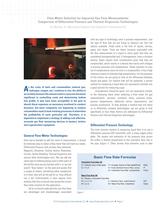
As the costs of fuels and consumables (natural gas, hydrogen, oxygen, etc.) continue to rise, the ability to accurately measure the amount used in a process becomes significant in controlling costs and determining bottom line profits. It may have been acceptable in the past to absorb these expenses as necessary overhead to conduct business, but more companies are beginning to analyze consumables used in heat-treating processes to determine the profitability of each particular job. Therefore, it is important to implement a strategy of adding cost effective, accurate gas flow measuring...
Open the catalog to page 2
similar measurements with DP transmitters are pitot tubes, averaging pitot tubes (e.g. Annubars), v-wedges, and v-cones (e.g. McCrometer). These same instruments are often selected in gas flow measurement based upon maintaining commonality of instrumentation throughout a facility. While this makes sense from a maintenance and inventory standpoint, our real objective is to improve the gas flow measurement of the process. Since we are now trying to measure a compressible gas, we have to recognize that knowing the mass flow rate is more beneficial than the volumetric flow rate (Figure 2)....
Open the catalog to page 3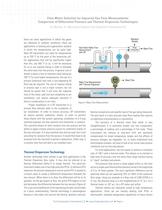
there are many applications in which the gases are delivered at ambient conditions, there are applications in heating and cogeneration systems in which the temperatures can be quite high. Most DP transmitters are rated for temperatures up to 250 °F at the point of the measuring cell. For applications that will be significantly higher than this, say 500 °F or so, it will be necessary for us to use impulse tubing in order to dissipate the extra heat from the process. A general rule of thumb is about a foot of stainless steel tubing per 100 °F. For even higher temperatures, the use of a...
Open the catalog to page 4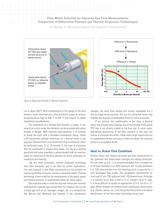
run to about 350°F. With modifications to the design of the flow element, some manufacturers offer variations suited to process temperatures as high as 500 °F to 850 °F that require no added installation considerations. The installation of a thermal flow element is simple. In the case of an in-line meter, the elements can be provided with either threads or flanges. With insertion type elements, it is common to install the units with a threaded compression fitting. Unlike a DP transmitter, periodic calibration of a thermal meter is not required. Manufacturers may recommend that a calibration...
Open the catalog to page 5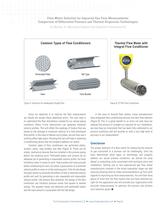
Since our objective is to improve the flow measurement we should not accept these additional errors. The next step is to understand the flow disturbance created by our actual piping conditions. Many in-line obstructions can generate distorted velocity profiles. This will affect the readings of meters that are based on the average or maximum velocity of a fully developed flow profile. In the case of elbows out of plane, we will also see a swirling effect take place. Knowing this fact will help in selecting a conditioning device that will properly address our needs. Common types of flow...
Open the catalog to page 6Archived catalogs
-
MT series
12 Pages
-
FCI Vortab Flow Conditioners
6 Pages
-
ST75
8 Pages
-
ST50
4 Pages
-
ST100
20 Pages
-
FCI Aerospace Products
8 Pages
-
FCI Nuclear Products
16 Pages
-
ST51
2 Pages
-
FLT
8 Pages
-
FCI
12 Pages
-
FCI Product Line Brochure
12 Pages





























